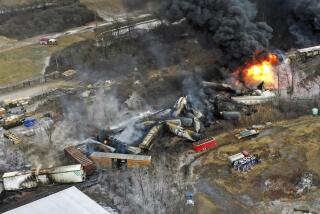Most Firestone Failures on Rear, Analysis Finds
WASHINGTON — Most motorist complaints about Bridgestone/Firestone tires involved failures on the rear wheels, which are particularly treacherous in sport-utility vehicles traveling at highway speeds, a Times analysis of government data shows.
According to the computer analysis, 56% of the complaints to the National Highway Traffic Safety Administration involved failures of rear tires. Just 14% cited front tires.
Another 25% of the complaints did not specify the position of the failed tire, while 5% involved both front and rear failures.
Contrary to the widespread perception that front tires are the most critical for safety, experts say failure of a rear tire is much more difficult to recover from--and more frightening--than a front-tire problem.
A key difference is that steering is of little help, especially if the tread peels off a rear tire. Indeed, it may only provoke a side skid that hastens loss of control and precipitates a rollover crash.
“When you have a rear-wheel failure, it’s much more severe than a front-wheel failure,” said Dennis Carlson, a former Michelin tire designer. “The vehicle becomes dynamically unstable.” Carlson now works as a consultant for plaintiffs in liability suits.
Because of their higher centers of gravity, SUVs are considered more rollover-prone than other cars.
A Times analysis of 621 tire complaints being investigated by the government in connection with the recall also found that:
* The complaints were more evenly distributed across the country than those received by Firestone. While the tire company said 80% of its complaints came from California, Texas, Florida and Arizona, a significantly smaller share of complaints to the government--62%--was from those four states. Federal authorities are considering whether to broaden the scope of the recall--which gave priority to Sunbelt states--that Firestone initiated last week. A Firestone spokesman said consumers anywhere in the country would be able to get tires replaced.
* More than half of the complaints--57%--involved tires that failed at highway speeds of at least 50 mph. Nearly a quarter were at speeds of 70 mph or higher. Friction causes tires to get hotter at higher speeds, and that could increase the likelihood of tread separation.
* Of 45 fatal accidents, 35 involved a rollover. A total of 54 people were reported killed in the crashes.
Last week, Firestone voluntarily recalled some 6.5 million tires, most of them installed as factory equipment on the Ford Explorer SUV. The recall affects 15-inch ATX, ATX II and Wilderness AT models.
NHTSA officials say they are trying to determine why the bulk of the cases involve complaints of rear-tire failure. “It’s one of the mysteries right now,” said agency spokesman Rae Tyson.
Possible explanations could range from different kinds of stress on the tires in the back to a greater likelihood that consumers would complain about a rear-tire failure because it is a more jarring experience.
When asked earlier in the week about why treads seemed more likely to come off rear tires, Bridgestone/Firestone Inc. Executive Vice President John Lampe said, “We have no explanation from a tire standpoint.”
In its own analysis, Ford Motor Co.’s findings parallel those of The Times. “The rear dominates over the front,” Tom Baughman, a Ford executive who oversees SUV production, said. “It looks like 60%-70% in the rear.”
Baughman said there were indications that the rear tire on the driver’s side was more likely to fail.
On an Explorer, the rear wheels would be the primary drive wheels, said Ford spokesman Mike Vaughn. In a fully loaded vehicle, the rear wheels would also be bearing the brunt of the weight.
Losing the tread on a rear tire would severely challenge the skills of most motorists, said Richard Baumgardner, a former Firestone engineer who now works as a consultant in liability suits.
“When the rear tread peels, the vibration would sound like somebody shooting a .50-caliber machine gun,” Baumgardner said. The vehicle begins to veer to the side of the failure. Instinctively, most drivers steer in the opposite direction to try and maintain their heading, but that only complicates matters.
“When the driver turns, he would find that the vehicle has lost its cornering ability,” Baumgardner said. “The rear end of the vehicle will start to slide, and when it starts to slide, the vehicle will roll.”
Carlson, the former Michelin tire designer, said the proper response to a rear-tire failure is counterintuitive: don’t hit the brakes and don’t make any sharp steering corrections.
“From the beginning of your driving experience you learn that the way to avoid accidents is to hit the brakes or steer around something,” Carlson said. “Those are the two normal reactions, but rear-tire failure is different than almost any type of vehicle emergency and that is what gets people.”
Baumgardner said some experts recommend that a driver accelerate to get rid of any remaining tire tread before attempting to stop.
He added that he believes front tires are failing at similar rates, but that consumers are not reporting the incidents because they are less likely to cause accidents. When the tread peels off a front tire, the steering wheel can still be used to control the vehicle.
The Times’ analysis of complaints to the government focuses on a somewhat smaller number of cases than cited elsewhere. Duplicate complaints were excluded from the analysis, as well as complaints involving tires made by other manufacturers and Firestone brands not subject to recall.
In other developments Thursday, Bridgestone/Firestone announced that it will indefinitely extend its policy of reimbursing consumers for tires replaced with a competitor’s brand. The announcement came after a Kentucky judge issued a temporary order barring the company from discontinuing the policy. A Bridgestone/Firestone spokeswoman said the company’s action was unrelated to the court order.
*
Times staff writer Terril Yue Jones in Detroit contributed to this report.






